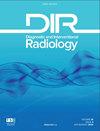Percutaneous drainage of retroperitoneal abscesses: variables for success, failure, and recurrence.
IF 1.7
4区 医学
Q2 Medicine
引用次数: 7
Abstract
PURPOSE We aimed to evaluate the success and failure rates and minor and major complications of percutaneous drainage of retroperitoneal abscesses. METHODS Between 1990 and 2010, percutaneously drained 170 retroperitoneal abscesses in 150 patients (83 males, 67 females, median age 44.2 years, age range, 1-86 years) were included retrospectively. Percutaneous drainage of retroperitoneal abscesses was performed under the guidance of ultrasonography and fluoroscopy or computed tomography. Six abscesses were drained via single needle aspiration whereas 164 abscesses were drained via catheters of 6-14 F calibre using the Seldinger technique. RESULTS When all retroperitoneal abscesses are considered, success rates were found as follows: 75.3% cure (128/170), 7.7% temporization (13/170), 4.1% palliation (7/170). Failure rate was 12.9% (22/170). Recurrence rate was 10.6% (18/170), and 13 of the recurred abscesses were treated via second session percutaneous drainage. Mortality rate was 2.7% (4/150). CONCLUSION Percutaneous drainage is the first treatment option for retroperitoneal abscesses due to procedural reliability, elimination of need for general anesthesia, better tolerability, and lower morbidity and mortality rates compared with the surgical methods. High cure, temporization, or palliation rates can be obtained via imaging-guided percutaneous drainage for all retroperitoneal abscesses with a safe access route.经皮腹膜后脓肿引流术:成功、失败和复发的变量。
目的评价经皮引流腹膜后脓肿的成功率、失败率及主要、次要并发症。方法回顾性分析1990 ~ 2010年经皮引流170例腹膜后脓肿的150例患者,其中男83例,女67例,中位年龄44.2岁,年龄范围1 ~ 86岁。经皮引流腹膜后脓肿在超声、透视或计算机断层扫描指导下进行。6个脓肿采用单针抽吸引流,164个脓肿采用Seldinger技术通过6- 14f口径导管引流。结果考虑所有腹膜后脓肿时,成功率为75.3%(128/170),7.7%(13/170),4.1%(7/170)。不良率为12.9%(22/170)。复发率为10.6%(18/170),13例复发脓肿行第二次经皮引流。死亡率为2.7%(4/150)。结论经皮穿刺引流术是腹膜后脓肿的首选治疗方法,与手术方法相比,经皮穿刺引流术操作可靠,无需全身麻醉,耐受性好,发病率和死亡率低。影像学引导下经皮引流术对所有腹膜后脓肿均可获得高治愈率、暂时治愈率或姑息率。
本文章由计算机程序翻译,如有差异,请以英文原文为准。
求助全文
约1分钟内获得全文
求助全文
来源期刊
CiteScore
3.50
自引率
4.80%
发文量
69
审稿时长
6-12 weeks
期刊介绍:
Diagnostic and Interventional Radiology (Diagn Interv Radiol) is the open access, online-only official publication of Turkish Society of Radiology. It is published bimonthly and the journal’s publication language is English.
The journal is a medium for original articles, reviews, pictorial essays, technical notes related to all fields of diagnostic and interventional radiology.

 求助内容:
求助内容: 应助结果提醒方式:
应助结果提醒方式:


